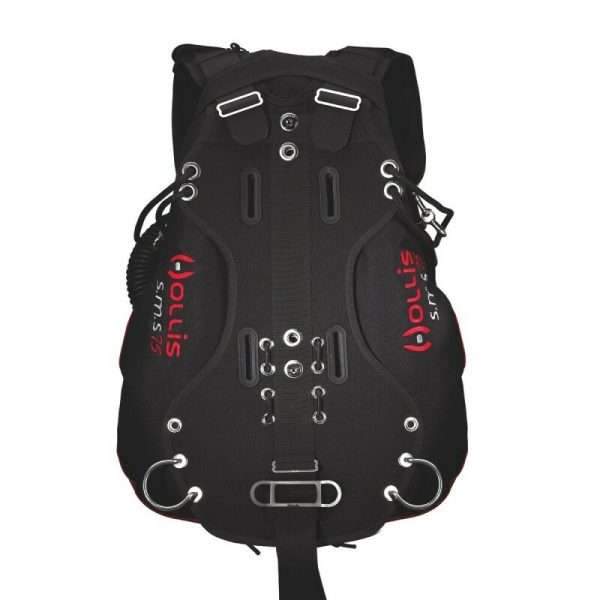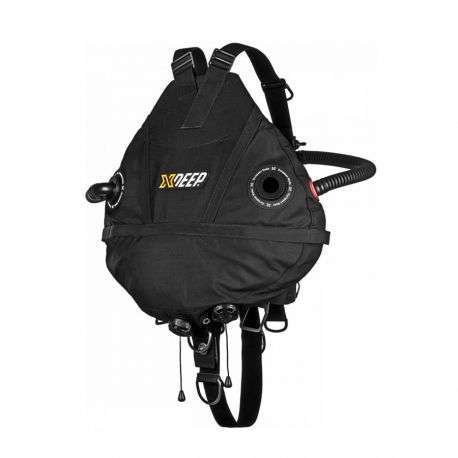You might have noticed a few configuration changes if you have been diving for a while already. Side Mount configuration is more widespread and popular worldwide wherever you dive.
There are many good reasons to dive Side Mount. One is safety; others include giving more flexibility and better-streamlining options. It is ideal for cave diving and is also very safe and comfortable for open-water diving.
Though a bit more complicated than back mount at the beginning and requiring finer tuning, you can eventually reach a higher level of comfort.
Side Mount diving looks incredibly easy and comfortable. And yes, it is! But it would be best if you didn’t underestimate the importance of good sidemount diving training, with appropriate and well-configured Side Mount gear.
Origin and evolution of Side Mount diving
Historically, Sidemount diving took its origin from sump diving in the UK. Dry cavers used this configuration to pass short, flooded cave passages, move tanks around, have more flexibility, dive through smaller passages, and reach places they couldn’t reach with the back mount configuration. Since these early days of side-mount for exploration, the technique has evolved, and times have changed.
A few years back, side mount was still considered a very specialized technique, mainly exclusively for cave divers and cave exploration purposes. It was all about exploring restricted passages. Sidemount training was not yet available. The equipment configuration was improvised and consisted of modifying existing dive gear, adding a bit of hardware here and there, and some bungees or shock cords to hold it all in place.
Check out our video of Sidemount restrictions
The diving equipment industry keeps bringing up significant innovations and developments with fantastic dive light technology, computers, and many dive accessories. And with Sidemount diving becoming so popular, many full side mount systems with dedicated harnesses and wings become available.
So without surprise, the apparition of commercial ready-to-dive Side Mount harnesses has led many divers, including non-cave-divers, to wear their tanks on their sides. Sidemount has gained a great deal of popularity and even became fashionable.
Many side mount divers enjoyed the configuration so much that they began bringing it on dive boats for open-water diving. Using two tanks or just one and Sidemount is not just for cave divers anymore.
Side Mount systems
To begin with, most mainstream manufacturers such as Dive Rite, Apeks, Hollis, and Halcyon have implemented harnesses, butt-plates, and wings designed explicitly for side mount diving. And a few brands, such as Razor and X-deep, have even come to light and became famous for their highly performant systems with great attention to detail.
We present a quick overview of some of the most popular Side Mount systems on the market. Many more are available, but not all are suitable for cave and tech diving. (The prices are given as an indication and depend on the Country, Shop, model, options, etc.) Consult your instructor before buying your system.

Razor 4
Lift Capacity: 35lb/15.8 kg
Redundant bladder
Sizing: One size fits all
Price: $739.00 US (with pouch)
ORDER HERE

Nomad Ray Sidemount System
Lift Capacity: 42 lbs/19 kg
Bailout bladder (option): 25 lb/11.3kg
Sizing: One size fits all
Weight: 5.7 lbs. (2.6 kg)
Price: $xxx.00 US

Apeks WSX-45
Lift Capacity: 45lb/20.4 kg
Sizing: Exist in 25lb lift capacity
Price: $845.00 US

Hollis SMS 75
Lift Capacity: 35 lb/15.8 kg
Sizing: SM/MD, LG/XL, XXL
Weight:
Price: $699.95 US

XDeep Stealth 2.0 Tec RB
Lift Capacity: 52 (23.6 kg)
Double bladder
Weight: 13.2 lbs (6 kg)
Sizing: One size fits all (several models available)
Price: $831.00 US
Side Mount Diving training
Several agencies now offer Sidemount courses, including SDI and TDI.
Go Side Mount has even designed a complete Razor side mount program for open water diving and cave diving to benefit from all the specifics of the Razor system. The high-quality training was designed by some of the pioneers in Side Mount diving, and the basic Side Mount program is a stepping stone to any technical diving.
Side mount with a single tank, sometimes called monkey diving, is very comfortable and proves the versatility of the equipment for recreational diving. Your sidemount instructor should discuss adjusting your configuration to a single tank as part of your side mount training and let you try it.
With high-quality Side mount courses and very qualified and experienced Side mount instructors, it is only natural that tech divers in the ocean started using Side mount with numerous tanks and for deep diving. And, of course, lately, we have seen an explosion in Side Mount rebreathers, to name a few, the Liberty, the Sidewinder, the Sidekick, and soon-to-come a conversion kit for the Megalodon. These units all have the advantage of being considerably lighter, which is an excellent benefit for any traveling diver. Thus the overall configuration Sidemount harness and rebreather is more traveler-friendly.
Side Mount versus Backmount
It all started with backmount
TDI was founded in 1994; back then, technical and cave divers wore almost universally twinsets in the Hogarthian configuration, with a long hose and wing inflator on the Right Side and a backup regulator with the SPG on the left, and a generally minimalist approach to gear selection. If this back mount configuration was the only acceptable solution for any dive applications, its popularity has faded over the years, and technical divers have opened their minds to more options.
First advantages of Side Mount vs Backmount: on land and on a boat
With a side mount configuration, the tanks are independent, bringing advantages on land, boat, and underwater.
Single tanks are always available. They can be carried separately and attached to the water. This makes the dive preparation easier on the diver’s back and knees.
Personally, as an avid diver and a dive professional, diving side mount has made all my diving more enjoyable and considerably reduced back pain! I don’t dive every day but certainly as often as possible, which is very often… and I believe I would not be diving so frequently and possibly not professionally anymore if I still had to wear twinsets for all my diving.
It feels terrific to take all the tanks off in the water, pass them to the boat captains and then climb up the ladder wearing only a lightweight harness, especially after a technical dive. And for cave diving, it becomes easier to get in and out of the water.
Advantages of Side Mount underwater
Each tank has a first and second stage and an SPG, offering similar gas management options as a twinset. The valves and first stages are within sight and easily accessible on the Side rather than in the diver’s back which is a great advantage. This great benefit has convinced many SM divers, including myself, that side mount can be safer in case of free-flow, runaway inflator (wing or drysuit), or any other O-ring bursting issues. It makes valve shutdowns easier and faster! It also makes feathering (opening and closing the valve to control the gas flow) a realistic option in an emergency.
The Side mount diver, the photographer, in particular, can also appreciate the increased head mobility, with the possibility to look in any direction without being bothered by the manifold and enjoy a more relaxed position of the neck.
Advantages for the traveling diver
Check out the video of Bull sharks diving in Playa del Carmen with seven monkey divers!
When traveling, an SM harness is considerably lighter than a heavy backplate, and less bulky, and keeps with regular weight luggage allowance. Renting single tanks is always possible at any dive destination; twinset might not! Standard scuba cylinders can quickly be prepared for side mount with minimal change and little extra gear. Almost any sized scuba cylinder can be converted for side mount in a few minutes with a couple of cam bands.
Wreck diving
One of the primary interests of moving cylinders from the back to the Side was to pass through low ceilings and flat bedding planes. If cave divers have found it very convenient over time, wreck divers naturally feel that side mount offers real advantages inside a wreck. Most wrecks offer challenges because of the possibility of entanglement with overhead objects and cables. But of course, if being a sidemount diver offers a nice option, it does not replace wreck diving training. Like any advanced diving, we strongly recommend you seek proper training and learn proper techniques.
Is Side Mount the one and only configuration for tech diving?
Of course not! Remember, no single configuration is right for ALL applications. Sidemount is not a magical solution and might not be the best option on all occasions. A growing number of recreational and tech divers have adjusted their skills and way of diving in Side Mount in many different environments; we still recommend having good knowledge and building up your experience in both configurations. Unless you have physical restrictions, some advantages to back mount diving are worth experiencing as a tech diver.
Good thoughts from the experts: Why Side-mount? By Steve Bogaerts
Side-mount is a tool and not the only way to dive or even the best way in some circumstances or environments.
The most important thing is the dive itself, staying safe, being comfortable, and having fun while minimizing any environmental impact, NOT the particular style of equipment configuration chosen.
However, of all the diving tools available, Side-mount is inherently the safest and most flexible for the widest range of applications and environments.
Side-mount configuration allows the diver to be:
1) Completely self-sufficient and self-reliant but still able to dive in a team environment with a strong team philosophy.
2) Independent with greater redundancy and more potential solutions in the event of a problem or emergency and therefore better able to self-rescue or assist another team member with less personal risk.
3) Able to dive solo or as part of a team with an enhanced degree of safety without having to change, modify or add anything in terms of equipment, procedures, or skills.
4) Flexible to meet the challenges of a changing environment or changing conditions of the environment or divers’ individual physical limitations.
SMB 2017
Video of basic skills demonstration by Steve Bogaerts
Can I try Side Mount diving?
If you’re curious about Sidemount diving, contact Deep Dark Diving for a try-dive and basic training day. It is a great way to learn and experience the best ways to route hoses, light cables, position dive accessories, and configure tanks and regulators. Discover a flexible alternative to the traditional tech diver’s configuration and make up your mind.
If you want to move to tech or cave diving and are not yet sure which configuration, we offer try-dives in back mount too, do not hesitate to schedule a couple of try-dives before.





